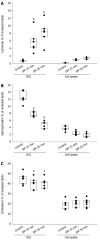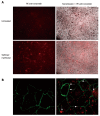Exogenous sphingomyelinase causes impaired intestinal epithelial barrier function
- PMID: 17876892
- PMCID: PMC4171303
- DOI: 10.3748/wjg.v13.i39.5217
Exogenous sphingomyelinase causes impaired intestinal epithelial barrier function
Abstract
Aim: To test the hypothesis that hydrolysis of sphingomyelin to ceramide changes the composition of tight junctions (TJs) with increasing permeability of the intestinal epithelium.
Methods: Monolayers of Caco-2 cells were used as an in vitro model for the intestinal barrier. Permeability was determined by quantification of transepithelial flux and transepithelial resistance. Sphingolipid-rich membrane microdomains were isolated by a discontinuous sucrose gradient and characterized by Western-blot. Lipid content of microdomains was analysed by tandem mass spectrometry. Ceramide was subcellularly localized by immunofluorescent staining.
Results: Exogenous sphingomyelinase increased transepithelial permeability and decreased transepithelial resistance at concentrations as low as 0.01 U/mL. Lipid analysis showed rapid accumulation of ceramide in the membrane fractions containing occludin and claudin-4, representing TJs. In these fractions we observed a concomitant decrease of sphingomyelin and cholesterol with increasing concentrations of ceramide. Immunofluorescent staining confirmed clustering of ceramide at the sites of cell-cell contacts. Neutralization of surface ceramide prevented the permeability-increase induced by platelet activating factor.
Conclusion: Our findings indicate that changes in lipid composition of TJs impair epithelial barrier functions. Generation of ceramide by sphingomyelinases might contribute to disturbed barrier function seen in diseases such as inflammatory, infectious, toxic or radiogenic bowel disease.
Figures





Similar articles
-
Tumor necrosis factor alpha increases epithelial barrier permeability by disrupting tight junctions in Caco-2 cells.Braz J Med Biol Res. 2010 Apr;43(4):330-7. doi: 10.1590/S0100-879X2010007500020. Epub 2010 Mar 19. Braz J Med Biol Res. 2010. PMID: 20445948
-
Methotrexate modulates tight junctions through NF-κB, MEK, and JNK pathways.J Pediatr Gastroenterol Nutr. 2012 Apr;54(4):463-70. doi: 10.1097/MPG.0b013e318247240d. J Pediatr Gastroenterol Nutr. 2012. PMID: 22197938
-
Roles of ZO-1, occludin, and actin in oxidant-induced barrier disruption.Am J Physiol Gastrointest Liver Physiol. 2006 Feb;290(2):G222-31. doi: 10.1152/ajpgi.00301.2005. Epub 2005 Oct 20. Am J Physiol Gastrointest Liver Physiol. 2006. PMID: 16239402
-
Molecular mechanism of intestinal permeability: interaction at tight junctions.Mol Biosyst. 2008 Dec;4(12):1181-5. doi: 10.1039/b800402a. Epub 2008 Oct 2. Mol Biosyst. 2008. PMID: 19396381 Review.
-
The cell surface and disease.Clin Sci (Lond). 1982 Jul;63(1):1-9. doi: 10.1042/cs0630001. Clin Sci (Lond). 1982. PMID: 7044653 Review. No abstract available.
Cited by
-
Boswellic acid inhibits expression of acid sphingomyelinase in intestinal cells.Lipids Health Dis. 2009 Dec 1;8:51. doi: 10.1186/1476-511X-8-51. Lipids Health Dis. 2009. PMID: 19951413 Free PMC article.
-
The Role of Sphingolipids on Innate Immunity to Intestinal Salmonella Infection.Int J Mol Sci. 2017 Aug 7;18(8):1720. doi: 10.3390/ijms18081720. Int J Mol Sci. 2017. PMID: 28783107 Free PMC article. Review.
-
An untargeted metabolomic study using MALDI-mass spectrometry imaging reveals region-specific biomarkers associated with bowel inflammation.Metabolomics. 2024 Dec 14;21(1):5. doi: 10.1007/s11306-024-02200-4. Metabolomics. 2024. PMID: 39674857 Free PMC article.
-
Lipid alterations in experimental murine colitis: role of ceramide and imipramine for matrix metalloproteinase-1 expression.PLoS One. 2009 Sep 29;4(9):e7197. doi: 10.1371/journal.pone.0007197. PLoS One. 2009. PMID: 19787068 Free PMC article.
-
Ceramide signaling in the gut.Mol Cell Endocrinol. 2022 Mar 15;544:111554. doi: 10.1016/j.mce.2022.111554. Epub 2022 Jan 5. Mol Cell Endocrinol. 2022. PMID: 34998898 Free PMC article. Review.
References
-
- Hollander D. Intestinal permeability, leaky gut, and intestinal disorders. Curr Gastroenterol Rep. 1999;1:410–416. - PubMed
-
- Playford RJ, Ghosh S. Cytokines and growth factor modulators in intestinal inflammation and repair. J Pathol. 2005;205:417–425. - PubMed
-
- Kim MY, Linardic C, Obeid L, Hannun Y. Identification of sphingomyelin turnover as an effector mechanism for the action of tumor necrosis factor alpha and gamma-interferon. Specific role in cell differentiation. J Biol Chem. 1991;266:484–489. - PubMed
-
- Schütze S, Potthoff K, Machleidt T, Berkovic D, Wiegmann K, Krönke M. TNF activates NF-kappa B by phosphatidylcholine-specific phospholipase C-induced "acidic" sphingomyelin breakdown. Cell. 1992;71:765–776. - PubMed
-
- Schissel SL, Keesler GA, Schuchman EH, Williams KJ, Tabas I. The cellular trafficking and zinc dependence of secretory and lysosomal sphingomyelinase, two products of the acid sphingomyelinase gene. J Biol Chem. 1998;273:18250–18259. - PubMed
Publication types
MeSH terms
Substances
LinkOut - more resources
Full Text Sources
Miscellaneous

